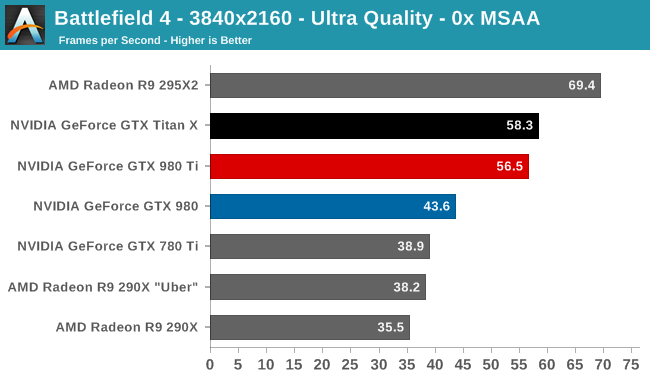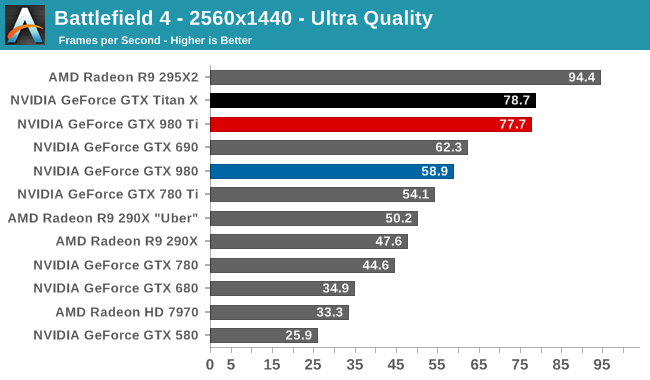The NVIDIA GeForce GTX 980 Ti Review
by Ryan Smith on May 31, 2015 6:00 PM ESTBattlefield 4
Kicking off our benchmark suite is Battlefield 4, DICE’s 2013 multiplayer military shooter. After a rocky start, Battlefield 4 has since become a challenging game in its own right and a showcase title for low-level graphics APIs. As these benchmarks are from single player mode, based on our experiences our rule of thumb here is that multiplayer framerates will dip to half our single player framerates, which means a card needs to be able to average at least 60fps if it’s to be able to hold up in multiplayer.



Battlefield 4 is going to set the pace for the rest of this review. In our introduction we talked about how the GTX 980 Ti may as well be the GTX Titan X, and this is one such example why. With a framerate deficit of no more than 3% in this benchmark, the difference between the two cards is just outside the range of standard run-to-run experimental variation that we see in our benchmarking process. So yes, it really is that fast.
In any case, after stripping away the Frostbite engine’s expensive (and not wholly effective) MSAA, what we’re left with for BF4 at 4K with Ultra quality puts the 980 Ti in a pretty good light. At 56.5fps it’s not quite up to the 60fps mark, but it comes very close, close enough that the GTX 980 Ti should be able to stay above 30fps virtually the entire time, and never drop too far below 30fps in even the worst case scenario. Alternatively, dropping to Medium quality should give the card plenty of headroom, with an average framerate of 91.8fps meaning even the lowest framerate never drops below 45fps.
Meanwhile our other significant comparison here is the GTX 980, which just saw its price cut by $50 to $499 to make room for the GTX 980 Ti. At $649 the GTX 980 Ti ideally should be 30% faster to justify its 30% higher price tag; here it’s almost exactly on that mark, fluctuating between a 28% and 32% lead depending on the resolution and settings.
Finally, shifting gears for a moment, gamers looking for the ultimate 1440p card will not be disappointed. GTX 980 Ti will not get to 120fps here (it won’t even come close), but at 77.7fps it’s well suited for driving 1440p144 displays. In fact and GTX Titan X are the single-GPU cards to do better than 60fps at this resolution.










290 Comments
View All Comments
chizow - Monday, June 1, 2015 - link
Yes, its unprecedented to launch a full stack of rebrands with just 1 new ASIC, as AMD has done not once, not 2x, not even 3x, but 4 times with GCN (7000 to Boost/GE, 8000 OEM, R9 200, and now R9 300) Generally it is only the low-end, or a gap product to fill a niche. The G92/b isn't even close to this as it was rebranded numerous times over a short 9 month span (Nov 2007 to July 2008), while we are bracing ourselves for AMD rebrands going back to 2011 and Pitcairn.Gigaplex - Monday, June 1, 2015 - link
If it's the 4th time as you claim, then by definition, it's most definitely not unprecedented.chizow - Monday, June 1, 2015 - link
The first 3 rebrands were still technically within that same product cycle/generation. This rebrand certainly isn't, so rebranding an entire stack with last-gen parts is certainly unprecedented. At least, relative to Nvidia's full next-gen product stack. Hard to say though given AMD just calls everything GCN 1.x, like inbred siblings they have some similarities, but certainly aren't the same "family" of chips.Refuge - Monday, June 1, 2015 - link
Thanks Gigaplex, you beat me to it... lolchizow - Monday, June 1, 2015 - link
Cool maybe you can beat each other and show us the precedent where a GPU maker went to market with a full stack of rebrands against the competition's next generation line-up. :)FlushedBubblyJock - Wednesday, June 10, 2015 - link
Nothing like total fanboy denialKevin G - Monday, June 1, 2015 - link
The G92 got its last prebrand in 2009 and was formally replaced on in 2010 by the GTX 460. It had a full three year life span on the market.The GTS/GTX 200 series as mostly rebranded. There was the GT200 chip on the high end that was used for the GTX 260 and up. The low end silently got the GT216 for the Geforce 210 a year after the GTX 260/280 launch. At this time, AMD was busy launching the Radeon 4000 series which brought a range of new chips to market as a new generation.
Pitcairn came out in 2012, not 2011. This would mimic the life span of the G92 as well as the number of rebrands. (It never had a vanilla edition, it started with the Ghz edition as the 7870.)
chizow - Monday, June 1, 2015 - link
@Kevin G, nice try at revisionist history, but that's not quite how it went down. G92 was rebranded numerous times over the course of a year or so, but it did actually get a refresh from 65nm to 55nm. Indeed, G92 was even more advanced than the newer GT200 in some ways, with more advanced hardware encoding/decoding that was on-die, rather than on a complementary ASIC like G80/GT200.Also, at the time, prices were much more compacted at the time due to economic recession, so the high-end was really just a glorified performance mid-range due to the price wars started by the 4870 and the economics of the time.
Nvidia found it was easier to simply manipulate the cores on their big chip than to come out with a number of different ASICs, which is how we ended up with GTX 260 core 192, core 216 and the GTX 275:
Low End: GT205, 210, GT 220, GT 230
Mid-range: GT 240, GTS 250
High-end: GTX 260, GTX 275
Enthusiast: GTX 280, GTX 285, GTX 295
The only rebranded chip in that entire stack is the G92, so again, certainly not the precedent for AMD's entire stack of Rebrandeon chips.
Kevin G - Wednesday, June 3, 2015 - link
@chizowOut of that list of GTS/GTX200 series, the new chip in that line up in 2008 was the GT200 and the GT218 that was introduced over a year later in late 2009. For 9 months on the market the three chips used in the 200 series were rebrands of the G94, rebrands of the G92 and the new GT200. The ultra low end at this time was filled in by cards still carrying the 9000 series branding.
The G92 did have a very long life as it was introduced as the 8800GTS with 512 MB in late 2007. In 2008 it was rebranded the 9800GTX roughly six months after it was first introduced. A year later in 2009 the G92 got a die shrink and rebranded as both the GTS 150 for OEMs and GTS 250 for consumers.
So yeah, AMD's R9 300 series launch really does mimic what nVidia did with the GTS/GTX 200 series.
FlushedBubblyJock - Wednesday, June 10, 2015 - link
G80 was not G92 not G92b nor G94 mr kevin g